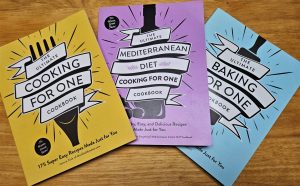Dining has changed from a social activity to little more than a chore. Granted, Dan’s appetite faltered considerably over the past year or two. As Covid threw a pall over all our lives, I had taken over food shopping as a defensive posture. Dan’s increasing fragility meant that I never handed the task back to him. I did more and more cooking, as well, often as he kibbitzed from his seat in the living room.
Backseat driving, whatever the activity, was his passion. There was pretty much nothing someone else was doing that he didn’t think his contributions would improve. But then, as I said, dining—and the preparations it involved—was a social activity.
A Well-Stocked Larder
The freezer is still stocked with food. Meats—chicken, pork, sausages and whatnot—are wrapped in single portions. Quart containers of soups, casseroles, the remains of many a past feast, are stacked therein. A few containers of homemade chicken stock survive and there are still some Luigi’s frozen Italian ice cups for dessert.
These potential meals are tasty and all they require is defrosting and heating. Rather like the packaged meals that fill the freezer aisles in the grocery stores. Preparing them, though, just isn’t cooking.
Is cooking a thing one does for oneself? I checked out the proposition online.
Cookbooks
Joanie Zisk runs a website called “One Dish Kitchen.” Her volume (yellow cover) initiates the series with The Ultimate Cooking for One Cookbook. Kelly Jaggers picks up with volumes two and three (lavender and light blue covers): The Ultimate Mediterranean Diet Cooking for One Cookbook and The Ultimate Baking for One Cookbook. Volumes one and two come with the tagline, “No Waste, Great Taste.” More about that later.
Bought’em all. Have tried a number of recipes.
Taste Testing
That blueberry muffin on page 27 of the yellow book? It’s okay, but a little tedious to make and needs much more than 15 minutes to bake. The chickpea curry on page 163 is just excellent though. Again, a lot of steps, a lot of dirty dishes. Spinach orzo salad? Delicious but… you get my drift.
The zucchini lasagna, page 120 in the lavender book, was okay. I’m not the kind of person who has marinara sauce just sitting around but I do have cans of Hunt’s fire-roasted diced tomatoes, and that works pretty well. Results were okay, but dinner started with 30-plus minutes of salting zucchini slices to draw off the water. Then I had to evaluate oven-safe ware to find a baking dish of an appropriate size. The minestrone on page 73 called for kale, which I replaced with spinach. The recipe also listed low-sodium vegetable broth, and I have neither vegetable broth nor low-sodium anything in my kitchen.
There is, however, that homemade chicken stock.
“No Waste, Great Taste”
Uh, no, that’s really not true. These books set one up for waste.
The recipes essentially call for a couple tablespoons of this or two ounces or that, of ingredients that only come in much larger quantities. Fresh spinach comes in a bag and once that bag is opened, it is good for, at best, a week. Better plan on four or five recipes that involve spinach because otherwise green slime takes over the vegetable drawer.
As I leafed through the books, I was struck by the different forms of liquid dairy called for: 2% milk, heavy cream, almond milk, and so on. I have a hard enough time finding a quart of whole milk in the store, then using it in my morning tea before it goes bad. Stocking four or five kinds of milk products so that they are on hand when the recipe calls for them? I don’t think so.
Shopping Lists
The front matter of all three books offers advice on kitchen equipment and shopping. It even advises buying in the bulk aisle so you can get the modest amount you need. Everything is about purchasing in smaller quantities, and that makes sense although it seems to run counter to the recommendation that one always “stock up on staples.”
In the end, following the recipes leads—if your goal is “no waste” at any rate—inexorably to the same few ingredients prepared in similar ways until they are fully consumed. “Leftovers” by any other name, even if what is left over has not yet been cooked.
How Many Place Settings?
In the end, the recipes tend to fail because they are designed for a single plate. The soups and casseroles could easily be doubled or quadrupled and leftovers wrapped and frozen. This would also circumvent, to some extent, the feeling of performing a pantomime of domesticity. If you are going to eat alone, why pretend that cooking for one requires approximately the same time and effort and feeding the Seventh Cavalry?
There is now only a single place setting on my table. I read the papers and listen to NPR’s “Morning Edition” while I sit there and have my breakfast. Lunch and supper are more frequently consumed on the couch while I read or watch television. I often make an excellent meal for one.
But I do not forget that it is a single place setting.

